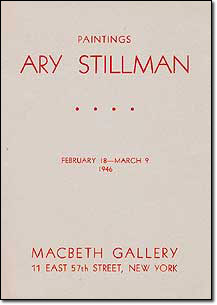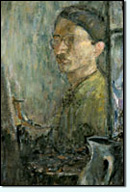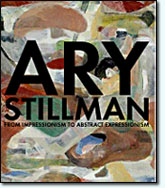Paintings,Ary Stillman at Macbeth Gallery
February 18-March 9, 1946, New York

Press Clippings
"Beauty of Color. Ary Stillman, who came to this country from Russia as a youth and recrossed the Atlantic to live for many years in Paris, has like many another creative artist, run through almost all the phases of artistic expression. Academy trained, he did his share of realistic landscapes and portraits – which soon took on poetic overtones – and was even interested in the primitive for a time.
To those who have watched his work for the last few years, his current exhibition at Macbeth will come as no particular shock, even though it is his first completely abstract show. Little by little, recognizable forms have given way to compositions constructed primarily of color. And what color! It sings, dances and broods by turns. It is laid on canvas tone on tone, hue on hue, integrated to build from and weight, space and perspective, and varied by texture. Stillman says that subject matter always interfered with this, and he is much happier with what he calls "intuitive" as against "conscious painting."
These new canvases bear in a direct relation to music and might appropriately be called tone poems. A number of them are on Indian themes, including the large "Indian Legend," with shimmering water suggested in the foreground, moving back and around, but always within the picture frame; and "Land of Poco Tempo," which hints of firelight and great butterflies. The eye dances about gaily in the bright "Frivolity," comes to rest in its opposite number, "Solitude." Variety of textures, superb color and a particularly coherent design in depth mark the composition titled "Shafts."
One could go on, but these paintings, so sensuous in surface quality and rich pigment, have to be seen to be appreciated."
The Art Digest
February 15, 1946
"Ary Stillman is the first abstract painter to have a one-man show at the Macbeth Gallery, and the event is a propitious one in every way. There is nothing strident or brash or coldly geometrical in Stillman’s abstracts; quite on the contrary, they have soft tapestry colors and textures, and a muted eloquence that invites protracted study. The general effect of each canvas is that of a thick shower of multi-colored flower petals; but each painting has its individual theme, the elements of which give the picture such structure as it has. No black-and-white reproduction can possibly suggest the original and poetic quality of these paintings. Go and see them if you can."
Pictures on Exhibit
March 1946
"Ary Stillman’s painting has undergone a sea change calculated to leave visitors to the Macbeth Gallery somewhat startled. From the early flaky-surface Impressionism he has developed a quite individual semi-abstract style dominated by a new lyric use of color and aiming at suggestion rather than representation. Paintings on Indian themes remind one of music – as, for example, Sibelius suggests an old tribal war mood in "Saga." And in "Frivolity," "Coq d’Or," and "Oriental Fantasy," color is reinforced by occasional linear or compositional devices to further his purpose."
The New York Times
Sunday, February 24, 1946
Some Exhibited Artwork Titles:
Indian Legend, Vista Mystique, Fountain, Voodoo, Indian Theme, Solitude, Land of Poco Tempo, Mosaic, Frivolity, Shafts, Green Orchids, Arabesque, Coq D'or, Oriental Fantasy, Spring.



